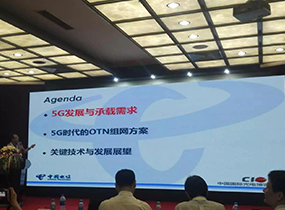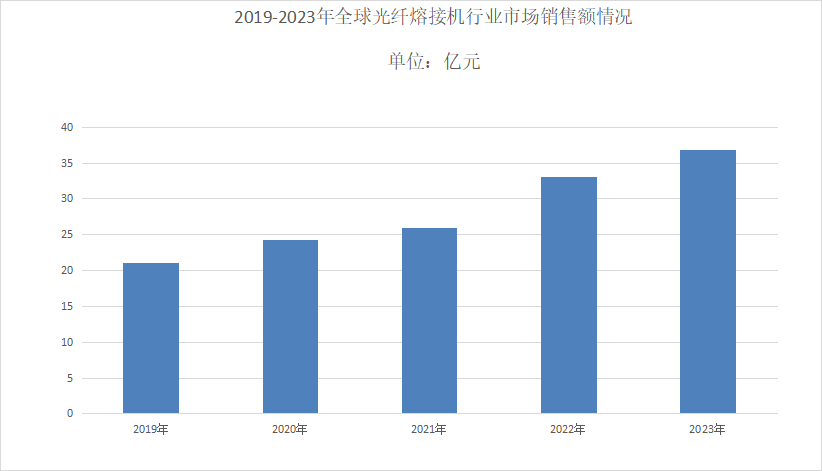
China Telecom has clearly defined the 5G carrying technology path: OTN/WDM is the perfect choice
With the rapid development of mobile Internet and communication technology, 5G technology has become the focus of the industry in recent years, and the research on 5G carrying solutions has also been put on the agenda. At the recently held "2017 Optical Communication Technology and Development Forum", Li Junjie, director of the Optical Communication Research Center of China Telecom Beijing Research Institute, elaborated on the optical transport network in the 5G era. He believes that the 5G bearer network is one of the key factors for the development of 5G networks and services, and OTN/WDW is the most perfect choice for 5G bearer technology.
The development of 5G puts forward new requirements for the bearer network
According to the 5G schedule of 3GPP, by 2020, the fifth-generation mobile communication (5G) will launch commercial services, and the new generation of information infrastructure featuring high speed, mobility, security and ubiquity will be basically completed. "5G commercialization starts with bearer networks," Li Junjie believes. In the 5G era, the demand for bearer networks mainly lies in the requirements for large bandwidth, ultra-low latency, high-precision clock synchronization, and network slicing.
In terms of large bandwidth, 5G offers higher speeds and wider bandwidths. It is expected that the 5G network speed will increase by about ten times compared to 4G, and the peak rate will rise from 100Mbit/s in 4G to tens of Gbit/s. Therefore, the capacity of access devices, aggregation devices, and core devices all need to be expanded rapidly. Meanwhile, in terms of low latency, services such as VR/AR, autonomous driving, and intelligent manufacturing all require ultra-low latency.
In terms of clock synchronization, the 5G synchronization service requirements consist of two parts: the basic service synchronization requirements for 5G TDD and the system service synchronization requirements. Among them, the basic service synchronization requirements of 5G TDD are expected to be comparable to those of 4G TDD. 1.5us (low frequency), 500ns (high frequency); The synchronization accuracy mainly depends on the requirements of collaborative services. The air interface frame length of 5G at 1ms is 10 times shorter than that of 4G at 10ms. It is expected that the synchronization accuracy index will also shrink. The specific index remains to be studied. Secondly, the 5G bearer frequency needs to support the direct clock with the service in one hop, reducing the processing of intermediate clocks, and the clock accuracy of a single node should meet the NS-level accuracy requirement.
In terms of network slicing, Li Junjie stated that the carrying network, through hard pipe methods, naturally supports the carrying requirements of 5G network slicing.
OTN/WDM is the best choice for 5G carrying technology
In the future, 5G needs to meet three typical application scenarios, including eMBB (Enhanced Mobile Broadband), uRLLC (Ultra-Reliable, Ultra-Low Latency Communication), and mMTC (Massive Internet of Things). Not only should the connection between people be addressed, but also the interconnection between people and things, as well as between things themselves, should be met. Therefore, the bearer network in the 5G era must achieve high bandwidth, low latency, network slicing, high reliability and open collaboration.
Li Junjie believes that the OTN integrated service bearer network in the 5G era will be able to meet all these demands. Firstly, the OTN bearer network features low-cost and high-bandwidth technologies. For short-range incoherent overclocking transmission technology, high-speed transmission is achieved by using low-rate optical devices. For medium and long-distance coherent transmission technology, it can achieve pluggability, low cost and low power consumption.
Secondly, the flexible multi-level OTN transmission technology can meet the requirements of the lowest latency, direct optical layer, and the breaking of loops in the fronthaul and midhaul to form a tree. ROADM equipment is sunk to the aggregation layer, accelerating the deployment of the optical layer and enhancing the flexibility of carrying capacity. Secondly, for ODUflex, it can achieve flexible interconnection interfaces and reuse low-cost ETH gray modules. Ultra-low latency OTN technology is optimized for 5G carrying scenarios, with single-node latency maintained at the 1us level. In terms of enhancing the routing and forwarding function, it can meet the flexibility requirements of 5G networking.
In addition, Li Junjie pointed out that 5G fronthaul is confronted with the challenge of insufficient optical fiber resources. In the initial stage of 5G, low-frequency networking is adopted, with a single base station having 3 cells and 6 optical fibers (single-fiber unidirectional) or 3 optical fibers (single-fiber bidirectional). Secondly, the optical fiber resources required for 3G/4G/5G co-stations are accumulated. In addition, during the mature period of 5G, high-frequency networking or low-frequency point addition will be adopted, which requires the addition of more optical fiber resources.
In response to this challenge, Li Junjie's WDM technology is an effective technical means to solve the prequel problem. The advantage of the active WDM/OTN solution lies in saving optical fibers. Cost savings can reduce the number of optical modules. Moreover, maintenance is simple, and passive OAD requires no maintenance. The challenge of the active WDM/OTN solution lies in the color light module. The packaging and power consumption need to reach the level of the white light module. Moreover, in terms of device management, the wireless device manages the color light module. He suggested adopting delay-optimized OTN encapsulation and inheriting OTN maintenance methods. Therefore, he believes that optical networks are the network technology with the lowest latency.
For the midhaul and backhaul bearer networks, Li Junjie stated that OTN inherently possesses large bandwidth and hard pipelines, while also having the capabilities of one-hop direct access at the optical layer and OTN delay optimization evolution, as well as rich management and operation and maintenance mechanisms. The end-to-end OTN networking has the strongest competitive advantage.
Li Junjie stated that the significance of 5G is not merely the next-generation wireless communication technology, but a revolution in the field of information and communication. He believes that the 5G bearer network is one of the key factors for the development of 5G networks and services, and OTN/WDM is the perfect choice for 5G bearer technology.
"5G is not all OTN/WDM integrated services. The bearer network will provide unified integrated bearer services for 5G, fixed broadband, cloud, and government and enterprise dedicated lines, etc." " Li Junjie emphasized.
相关新闻
-

What is the principle of optical fiber fusion splicing technology?
随着移动互联网和通信技术的飞速发展,5G技术在近几年成为业界焦点,5G承载方案研究也被提上议事日程。在近日举办的“2017光通信技术和发展论坛”上,中国电信北京研究院光通信研究中心主任李俊杰详细介绍了5G时代的光传送网,他认为,5G承载网是5G网络和业务发展的关键因素之一,而OTN/WDW是5G承载技术最为完美的选择.5G发 -

China Telecom has clearly defined the 5G carrying technology path: OTN/WDM is the perfect choice
随着移动互联网和通信技术的飞速发展,5G技术在近几年成为业界焦点,5G承载方案研究也被提上议事日程。在近日举办的“2017光通信技术和发展论坛”上,中国电信北京研究院光通信研究中心主任李俊杰详细介绍了5G时代的光传送网,他认为,5G承载网是5G网络和业务发展的关键因素之一,而OTN/WDW是5G承载技术最为完美的选择.5G发 -

Analysis of the prospects of the fiber optic splicer industry in 2024: The market size of fiber opti
随着移动互联网和通信技术的飞速发展,5G技术在近几年成为业界焦点,5G承载方案研究也被提上议事日程。在近日举办的“2017光通信技术和发展论坛”上,中国电信北京研究院光通信研究中心主任李俊杰详细介绍了5G时代的光传送网,他认为,5G承载网是5G网络和业务发展的关键因素之一,而OTN/WDW是5G承载技术最为完美的选择.5G发







